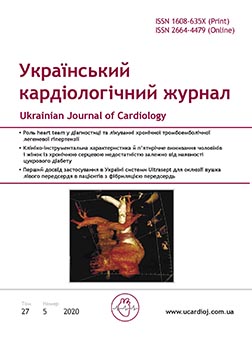Nonspecific aortoarteritis (Takayasu’s disease)
Main Article Content
Abstract
The article presents a clinical case of Takayasu’s disease (nonspecific aortoarteritis). On the example of the course of the disease in a young woman, the features of clinical symptoms and diagnostic difficulties are analyzed. Particular attention is paid to the visualization of vascular lesions and the assessment of the dynamics of changes in the vessels as the disease progresses. Changes in laboratory parameters are presented in details according with ongoing therapy. The analysis of literature data of the effectiveness of drug therapy for the disease was carried out. It is emphasized that there is a very limited number of quality placebo-controlled studies in the literature. The practicing physician can only rely on the results of observational studies in his decision’s making process. Also, all studies presented in the literature included a very small number of patients. The algorithm of therapy prescription is given, the first line of which is glucocorticoids. Although there are very few literature data, it is noted that the achievement of remission with isolated glucocorticoid therapy is observed in 50 % of patients. According to the updated EULAR recommendations, after disease verification, therapy should be initiated immediately, the recommended starting dose is 40–60 mg of prednisolone (or equivalent). After achieving control of the disease, it is recommended to gradually reduce the dose to the target 15–20 mg/day for 2 to 3 months after 1 year to 10 mg/day. The next step is to prescribe a non-glucocorticoid immunosuppressant in order to provide both a «steroid sparing» effect and long-term control under the disease. All available information on the efficacy of methotrexate, mycophenolate mofetil, cyclophosphophomide, leflunamide, and azathioprine comes from open-label prospective or retrospective studies with a limited number of participants. Tumor necrosis factor inhibitors and tocilizumab are recommended as second-line drugs. A satisfactory clinical and laboratory response was observed in more than 80 % of patients receiving tocilizumab therapy. In this clinical case, tocilizumab was used and the effects of the drug during treatment for 8 months are described in detail. Immunobiological therapy with tocilizumab was associated with a good clinical and laboratory response, a decrease in vascular stenosis, and an improvement in the patient’s well-being.
Article Details
Keywords:
References
Abisror N., Mekinian A, Lavigne C. et al.; Club Rhumatismes et Inflammation, and SNFMI. Tocilizumab in refractory Takayasu arteritis: a case series and updated literature review // Autoimmun. Rev.– 2013.– Vol. 12 (12).– P. 1143–1149. doi: https://doi.org/10.1016/j.autrev.2013.06.019.
Arend W.P., Michel B.A., Bloch D.A. et al. The American College of Rheumatology 1990 criteria for the classification of Takayasu arteritis // Arthritis & Rheumatism.– 1990.– Vol. 33 (8).– P. 1129–1134.
Barra L., Yang G., Pagnoux C. The Canadian Vasculitis Network. Non-glucocorticoid drugs for the treatment of Takayasu’s arteritis: A systematic review and meta-analysis // Autoimmun. Rev.– 2018.– Vol. 17 (7).– P. 683–693. doi: https://doi.org/10.1016/j.autrev.2018.01.019.
De Franciscis S., Serra R., Luongo A. et al. The management of Takayasu’s arteritis: personal experience // Ann. Vasc. Surg.– 2007.– Vol. 21 (6).– P. 754–760. doi: https://doi.org/10.1016/j.avsg.2007.03.021.
Goel R., Danda D., Joseph G. et al. Long-term outcome of 251 patients with Takayasu arteritis on combination immunosuppressant therapy: Single centre experience from a large tertiary care teaching hospital in Southern India // Semin. Arthritis Rheum.– 2018.– Vol. 47 (5).– P. 718–726. doi: https://doi.org/10.1016/j.semarthrit.2017.09.014.
Hellmich B., Agueda A., Monti S. et al. 2018 Update of the EULAR recommendations for the management of large vessel vasculitis // Ann. Rheum. Dis.– 2020.– Vol. 79 (1).– P. 19–30. doi: https://doi.org/10.1136/annrheumdis-2019-215672.
Hoffman G.S., Leavitt R.Y., Kerr G.S. et al. Treatment of glucocorticoid-resistant or relapsing Takayasu arteritis with methotrexate // Arthritis Rheum.– 1994.– Vol. 37 (4).– P. 578–582. doi: https://doi.org/10.1002/art.1780370420.
Li J., Yang Y., Zhao J. et al. The efficacy of Mycophenolate mofetil for the treatment of Chinese Takayasu’s arteritis // Sci Rep.– 2016.– Vol. 6.– P. 38687. doi: https://doi.org/10.1038/srep38687.
Misra D.P., Wakhlu A., Agarwal V., Danda D. Recent advances in the management of Takayasu arteritis // Int. J. Rheum. Dis.– 2019.– Vol. 22 (Suppl. 1).– P. 60–68. doi: https://doi.org/10.1111/1756-185X.13285.
Nakaoka Y., Isobe M., Takei S. et al. Efficacy and safety of tocilizumab in patients with refractory Takayasu arteritis: results from a randomised, double-blind, placebo-controlled, phase 3 trial in Japan (the TAKT study) // Ann. Rheum. Dis.– 2018.– Vol. 77 (3).– P. 348–354. doi: https://doi.org/10.1136/annrheumdis-2017-211878.
Ohigashi H., Haraguchi G., Konishi M. et al. Improved prognosis of Takayasu arteritis over the past decade-comprehensive analysis of 106 patients // Circ. J.– 2012.– Vol. 76 (4).– P. 1004–1011. doi: https://doi.org/10.1253/circj.cj-11-1108.
Pan L., Du J., Liu J. et al. Tocilizumab treatment effectively improves coronary artery involvement in patients with Takayasu arteritis // Clin. Rheumatol.– 2020.– Vol. 39.– P. 2369–2378. doi: https://doi.org/10.1007/s10067-020-05005-7.
Shelhamer J.H., Volkman D.J., Parillo J.E. et al. Takayasu’s arteritis and its therapy // Ann. lntern. Med.– 1985.– Vol. 103 (1).– P. 121–126. doi: https://doi.org/10.7326/0003-4819-103-1-121.
Silvestri V. The «Eternal Recurrence» of Arteritis. Suggesting Autoimmunity Underlining Friedrich Nietzsche’s Challenging Clinical Case // Ann. Vasc. Surg.– 2018.– Vol. 51.– P. 314–319. doi: https://doi.org/10.1016/j.avsg.2018.03.020.
Singh A., Danda D., Hussain S. et al. Efficacy and safety of tocilizumab in treatment of Takayasu arteritis: A systematic review of randomized controlled trials // Mod. Rheumatol.– 2020.– Feb 13.– P. 1–8. doi: https://doi.org/10.1080/ 14397595.2020.1724671.
Valsakumar A.K., Valappil U.C., Jorapur V. et al. Role of immunosuppressive therapy on clinical, immunological, and angiographic outcome in active Takayasu’s arteritis // J. Rheumatol.– 2003.– Vol. 30 (8).– P. 1793–1798.

